Visualizing the Report interactively
This task describes how to visualizing the Report interactively.
Import V5 data via FBDI. Consult the Import Report.
You have access to the following information:
-
Global Results html page: showing the list of the
batch inputs and the global status. The default name is "Global
Result" with date and time of the report.
-
A progress bar in the Global Results html page:
gives an indication about the process current state.
-
Warnings about the link isolation:
identifies the isolated links (not imported).
The message contains the pointing element isolated
from the pointed document.
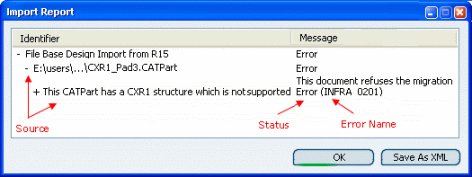
-
The left column shows the sources and the right
one the status and the details. An error name is given after the
error status. This is the unique identifier of this error.
-
The source corresponds to the origin of the
information. For example, it can be the name of the file, the container
or the feature that generates the problem.
-
The status of the information can have four
values, ordered by growing importance: OK, Warning, Unknown, Error.
-
The error name is the unique identifier of an error.
It is only used for information with an Unknown or Error status.
It is used in two ways: it produced statistics on the kind of errors
that we generally encounter and it will also make the communication
with the end user easier.
Expand or collapse information by double-clicking on
the corresponding lines. A sign indicates whether the reports are expanded,
preceded by a "-", or collapsed, preceded by a "+". Expanding information
shows the details and the children of this Report.
Note: Whenever a status of any element of the tree is
greater then the status of its parent, this status is reported to him.
To save this Report with the XML format, select
Save As XML in the Import Report, a Save As
window opens.
Choose a path and File name but you cannot change the
type extension: .xml is the unique choice.
Click Save. You can open the report with
the .xml extension:

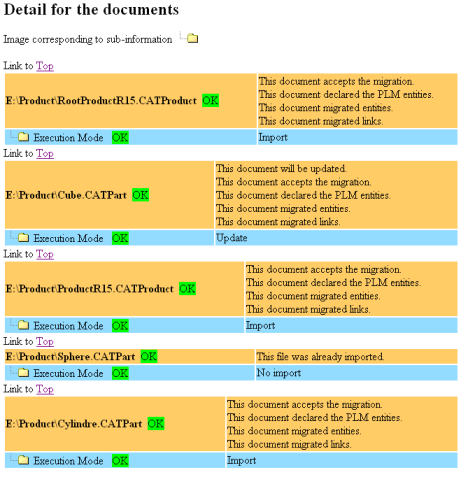
For information, there is a style sheet (.xls) for the
XML files, in order to organize the information of the FBDI Report like
in a web page. The user can customize this style sheet that is referenced
by the XML files.

Visualizing the Batch report (Standard Mode)
This task describes how to visualizing the Batch report (Standard Mode).
Import V5 data via the FBDI batch. Fore more information,
please refer to Running the FBDI Batch.
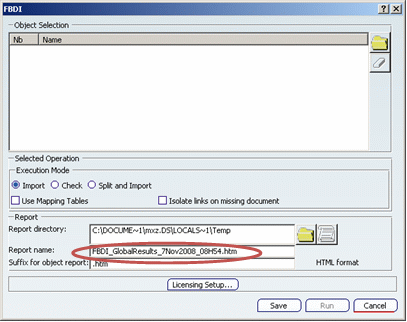
Consult the Import Report. which gives the
user a view of what has been imported.
You have access to the following information:
-
Global Results html page: showing the list of the
batch inputs and the global status. The default name is "Global
Result" with date and time of the report.
-
A progress bar in the Global Results html page:
gives an indication about the process current state.
-
Warnings about the link isolation:
identifies the isolated links (not imported).
The message contains the pointing element isolated
from the pointed document.
-
An Visualizing the Report file:
the report status has
a link to the xml report detailing the status
(OK or KO) of all the imported files.
Note: If the html file already exists,
a warning pop up when clicking the Run button. 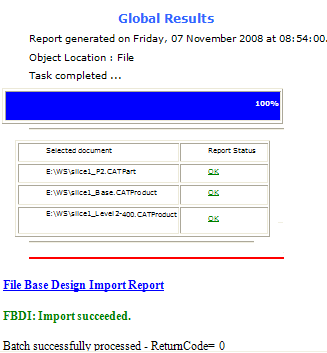

Visualizing the report after a Split Import
The Split Import consists in importing
a root product with links to sub-products and parts in separate packages. As the Split Import is CPU time consuming, it is useful
to know the current state of the migration. First or
intermediate results is helpful to know if the result of an assembly will
be different from V5.
In Split mode, as soon as a package of documents is migrated, intermediate
report summaries are provided to the user.
Import V5 data via FBDI in Split Mode.
For more information, please refer to
Importing V5 Data in Split and Massive Modes.
Consult the Import Report.
-
A "Global Results For Split"
html page for the main process: a new directory is created for all
the report files. Its name contains the date and time also used
by the Global Report result file. This directory contains all the
package report directories.
As soon as the results of a package
import have been collected, the Global Result file is updated. The
user can select all the information generated by the computed packages
(see the report image below with two packages).
The intermediate report gives
access to the first package results.
-
A directory containing all the
outputs. This directory is named with the date and time of the FBDI
Split batch execution.
-
A progress bar shows the import process progression
and gives an idea about the split import time.
-
Intermediate reports are created before the split
process achievement.
-
Warnings about the link isolation:
identifies the isolated links (not imported).
The message contains the pointing element isolated
from the pointed document.
-
A global xml report.
-
A "Package result" html page
and the corresponding xml report file for each sub process.
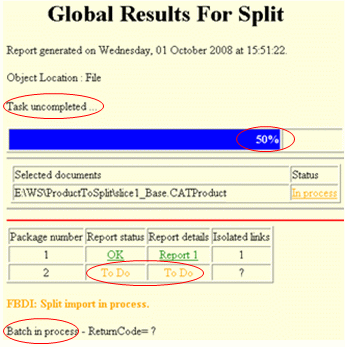
The running packages are reported
as "To Do" until their ending. Therefore, the expected report status
will be OK, KO, Partial and To Do. No information is given for the running
packages.
If the Split Import succeeds, read
the Global Result and check if the report is successful.
If the Split Import fails, read
the Global Result and identify the step which failed:
-
If the link analysis failed,
the document associated to this failure is indicated with the failure
root cause.
-
If an import failed, read
the report of the failed package import by selecting the link in
the Global report.
-
If the split import failed,
read the final report.
If a report with the same name already exist, a warning pop up.

XML Report
A warning may appear in the XML report when it has identified the isolated links.
The XML report only shows the status of the imported documents. The pointed documents that are not imported (can be missing or already imported by using the asynchronous mode) do not appear in the report.
In asynchronous mode, you obtain this message:If an input file is not imported (i.e. it was already imported using the asynchronous mode) it will appear in the report with a specific detail explaining the situation.
Note: The name of the Split Global Result file and its target directory are inputs. The names of the other created directories and files are supported by the national language.
The report is updated when a sub-process is collected by the
main process. So it is updated when the main process needs intermediate
results to continue. The Done status is only established
when you need its result to continue. The running processes
with their associated progress bar can be identified in grid
computing mode inside the CATUTIL window (see the Infrastructure
User Guide).
The isolation warning is available only when the application
allows it.
|
![]()

![]()
![]()




